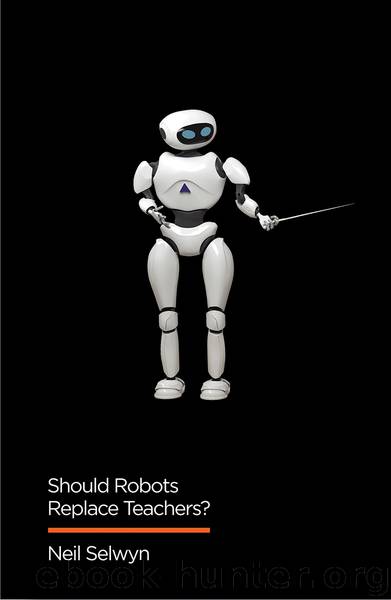Should Robots Replace Teachers? by Neil Selwyn

Author:Neil Selwyn
Language: eng
Format: epub
ISBN: 9781509528981
Publisher: Wiley
Published: 2019-04-11T00:00:00+00:00
A reduced synthetic experience?
First are questions of authenticity and depth of experience. All the systems and agents described in this chapter primarily support virtual representations of teaching. In theory, virtual agents are cheap to provide, and can support consistent, reliable teaching that is easily controlled and monitored. However, in theory, virtual technologies also offer the possibility to move beyond the limitations of real-life practices and processes, and allow learners to experience situations that otherwise would not be possible. Here, there is less sense of pedagogical agents extending the realms of learning and moving beyond what learners might otherwise experience. Besides the gimmick of talking to a bug, living on a space-station or teaching a computergenerated doppelganger, these systems mostly provide rudimentary replications of familiar ‘real-life’ learning processes and practices. Steve might well be able to walk someone through how to operate an air compressor on board a ship, but he is unlikely to lead them into otherwise unimaginable realms.
If anything, the forms of computer-based tutoring outlined in this chapter can be seen as abbreviated, bounded and ultimately reduced versions of fairly routine educational processes and practices. Key here is the limited nature of any interaction that a learner can expect to have with their ‘tutor’. As Campanelli and colleagues note, despite the ‘founding myth’ of interactivity, virtual technologies are only capable of offering the user an ‘infinite number of finite options’.32 An off-hand mention of Shakespeare is unlikely to trigger Herman The Bug to reflect on the influence of sixteenth-century art on botanical knowledge. Similarly, it could be argued that most aspects of human interaction can only be crudely simulated and approximated. It is difficult to describe how a teenage girl engages in ‘banter’ or how a butler might smile wryly. As such, it is incredibly difficult to automate and simulate these processes. All these intelligent systems and agents are essentially scripted and configured along limited lines. This can make interacting with such virtual technologies a frustratingly ‘castrated’ experience, offering ‘synthetic’ rather than ‘virtual’ experiences of real-life encounters with teachers and teaching.33
These systems invariably reduce any act of learning to an individual’s ability to respond to sets of pre-determined prompts and pre-programmed procedures. Even the most complex intelligent system is essentially built around closed forms of repetitive training. Despite claims of open-ended and socially rich learning, these systems are most successfully navigated along rational and repetitive lines. The ideal tutee of any intelligent tutoring system is someone who can adapt themselves to the expectations and requirements of the system in order to progress. In this sense, many learners will understandably attempt to ‘game’ their interactions with an agent – i.e. engage with the procedures in a strategic and calculated manner in order to trigger the ‘correct’ outcomes.
Despite the apparent complexity, diversity and creative design, any episode of agent-driven tutoring is invariably reduced to getting to know the system and being able to interpret and work with its coded logic – what could be termed a form of ‘algorithmic mastery’. This
Download
This site does not store any files on its server. We only index and link to content provided by other sites. Please contact the content providers to delete copyright contents if any and email us, we'll remove relevant links or contents immediately.
| Administration | Assessment |
| Educational Psychology | Experimental Methods |
| History | Language Experience Approach |
| Philosophy & Social Aspects | Reform & Policy |
| Research |
The Art of Coaching Workbook by Elena Aguilar(50884)
Trainspotting by Irvine Welsh(21493)
Twilight of the Idols With the Antichrist and Ecce Homo by Friedrich Nietzsche(18482)
Fangirl by Rainbow Rowell(9076)
Periodization Training for Sports by Tudor Bompa(8148)
Change Your Questions, Change Your Life by Marilee Adams(7616)
This Is How You Lose Her by Junot Diaz(6764)
Asking the Right Questions: A Guide to Critical Thinking by M. Neil Browne & Stuart M. Keeley(5609)
Grit by Angela Duckworth(5500)
Red Sparrow by Jason Matthews(5373)
Paper Towns by Green John(5072)
Room 212 by Kate Stewart(5018)
Ken Follett - World without end by Ken Follett(4625)
Housekeeping by Marilynne Robinson(4309)
The Sports Rules Book by Human Kinetics(4276)
Double Down (Diary of a Wimpy Kid Book 11) by Jeff Kinney(4189)
Papillon (English) by Henri Charrière(4181)
The Motorcycle Diaries by Ernesto Che Guevara(3995)
Exercise Technique Manual for Resistance Training by National Strength & Conditioning Association(3941)
